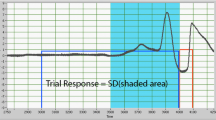Abstract
Sequential dependencies were examined as a function of learning, masking, and subject factors in a two-stage differential eyelid conditioning experiment. In Stage 1, all subjects were differentially conditioned to two Vanderplas and Garvin (1959) forms. In Stage 2, the conditional stimuli (CSs) were one of eight words, four reinforced (CS+) and four unreinforced (CS−), with taxonomic category (animalsvs. musical instruments) as the discriminandum, and different subjects were given semantic, physical, or no additional CS processing tasks. The results showed sizeable and highly significant sequential dependencies in the form of greater conditional response probabilities when CS + as opposed to CS− trials were recently experienced. These effects decreased overtrials, were greater in the groups given additional processing loads, and were in some cases greater in C-form responders than in V-form responders and greater in subjects who were unable to verbalize the differential contingencies. It was concluded that the magnitude of sequential dependencies was inversely related to the subject’s awareness of the differential contingencies and/or ability to use the contingency information to respond appropriately to the CS cues.
Similar content being viewed by others
References
Battig, W. F. and Montague, W. E.: Category norms for verbal items in 56 categories: A replication and extension of the Connecticut category norms. J. Exp. Psychol. Monogr.80, Part 2, 1969.
Grant, D. A.: A preliminary model for processing information conveyed by verbal conditioned stimuli in classical conditioning.In Black, A. H. and Prokasy, W. F. (eds.), Classical Conditioning II: Current Theory and Research. New York, Appleton-Century-Crofts, 1972.
Grant, D. A.: Cognitive factors in eyelid conditioning. Psychophysiology10, 75–81, 1973.
Hartman, T. F. and Ross, L. E.: An alternative criterion for the elimination of “voluntary” responses in eyelid conditioning. J. Exp. Psychol.61, 334–338, 1961.
Kadlac, J. A.: Individual Differences and Levels-of-Processing Tasks in Differential Eyelid Conditioning: Response Frequency, Topography, Cardiac Orienting, and Sequential Effects. Unpublished doctoral dissertation, University of Wisconsin-Madison, 1978.
Kadlac, J. A. and Grant, D. A.: Eyelid response topography in differential interstimulus interval conditioning. J. Exp. Psychol. Human Learn. Memory3, 345–355, 1977.
Kimble, G. A.: Hilgard and Marquis’ Conditioning and Learning. New York, Appleton-Century-Crofts, 1961.
Nelson, M. N. and Ross, L. E.: Effects of masking tasks on differential eyelid conditioning: A distinction between knowledge of stimulus contingencies and attentional or cognitive activities involving them. J. Exp. Psychol.102, 1–9, 1974.
Paivio, A.: Perceptual comparisons through the mind’s eye. Memory Cognit.3, 635–647, 1975.
Prokasy, W. F.: Developments with the two-phase model applied to human eyelid conditioning.In Black, A. H. and Prokasy, W. F. (eds.), Classical Conditioning II: Current Theory and Research. New York, Appleton-Century-Crofts, 1972.
Prokasy, W. F. and Allen, C. K.: Instructional sets in human differential eyelid conditioning. J. Exp. Psychol.80, 271–278, 1969.
Prokasy, W. F., Carlton, R. A. and Higgins, J. D.: Effects of nonrandom intermittent reinforcement schedules in human eyelid conditioning. J. Exp. Psychol.74, 282–288, 1967.
Ross, L. E.: Cognitive factors in conditioning: The use of masking tasks in eyelid conditioning.In Kendler, H. H., and Spence, J. T. (eds.), Essays in Neobehaviorism. New York, Appleton-Century-Crofts, 1971.
Vandament, W. E., Burright, R. G., Fessenden, R. R. and Barker, W. H.: Tables of event sequences for sequential analyses of data in psychological experiments containing two-class events. Behav. Res. Methods Instrument.2, 290–296, 1970.
Vanderplas, J. M. and Garvin, E. A.: The association value of random shapes. J. Exp. Psychol.57, 147–154, 1959.
Zajano, M. J. and Grant, D. A.: Response topography in the acquisition of differential eyelid conditioning. J. Exp. Psychol.103, 1115–1123, 1974.
Author information
Authors and Affiliations
Additional information
The research reported here served as part of a Ph.D. dissertation submitted to the University of Wisconsin at Madison (Kadlac, 1978). It was supported in part by funds provided to the late David A. Grant by U.S. Public Health Service Research Grant MH-06792.
Rights and permissions
About this article
Cite this article
Kadlac, J.A. Cognitive factors affecting sequential dependencies in differential eyelid conditioning. Pav. J. Biol. Sci.. 14, 191–198 (1979). https://doi.org/10.1007/BF03001981
Issue Date:
DOI: https://doi.org/10.1007/BF03001981




